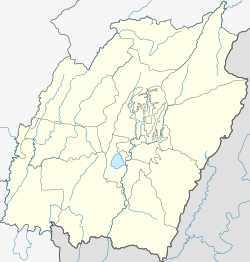Geography
The Gazetteer of Manipur (1886) mentions the village Mombi as being situated on a head-stream of the Chakpi River, [2] whose name is Tuiyang (or Tuingam). [7] [8] The Survey of India map, however, places the village on the ridge adjascent to the Tuiyang river valley. [7] The ridge currently houses the State Highway from Sugnu to the Myanmar border near Yangoulen and Khengjang villages (with a village called Tuivang being on the opposite side of the border in Myanmar). [9]
The entire ridge appears to constitute the "Lonpi/Mombi village". At the northwestern end of the ridge, which dips into the valley of Chakpi River is a "New Mombi" village, adjacent to Kuljang. [10] At the southeastern end of the ridge is a peak designated as "Lonpi Gamvet Mol", by the Government of Manipur, a scenic attraction. [11]
History
According to the Gazetteer of Manipur, the village of Mombi was settled by the Mangvung clan of Thadou Kukis (who were known as "Khongjais" in Manipur). [2] The Thadou were probably displaced from Mualpi in Chin Hills, and apparently reused that name (spelt "Mombi" by Manipuris) for their new village.
During the rule of Nara Singh (r. 1834–1850), the Kamhau-Sukte tribes apparently took possession of Mualpi and made several raids on southeastern Manipuri villages, including Mombi and Heeroway. In 1855, after Maharaja Chandrakirti Singh came to power, they burnt down the Namphou/Lamphou village, [b] which is further north close to Chandel. In 1857, the Maharaja led a 1,500-strong force against Kam Hau at Tedim, the chief of the tribes. But the effort failed, with the Manipuri commander getting killed and the troops dispersing "in confusion". The Maharaja was forced to agree to a border with Kam Hau along the Chakpi River. Thus Mombi remained in the hands of the Kamhau-Sukte tribes. The Maharaja established a border post at Namphou to the north of Mombi.
In 1872, the Maharaja sent an expedition to the Chivu salt springs (near modern Behiang on the present day southern border of Manipur), ostensibly to support the British Lushai Expedition. The Manipuri troops camped near Chivu for two months and, while returning, arrested the Kamhau chief of Mualpi who happened to pass through the area. Even though the British officials decried the arrest as "treachery", the Maharaja succeeded in marking his desired territorial boundary near Chivu.
After these events, the southern tribes continued to be either independent or paid tributes to the Kamhau-Suktes. From Mombi, the Kamhaus appear to have controlled the hills up to the Khuga River valley. The British administration reports describe a clash between Manipur's khongjai troops and the Kamhaus in 1876, where victory is claimed for the Manipur troops.
In 1894, The British delineated the border between Manipur and the "Chin Hills" region, which was to be awarded Burma. They ran the border close to the previously marked "Pemberton's line" and continued it to Chivu springs. According to scholar Pum Khan Pau, 47 tribal villages that paid tribute to the Kamhau chief were thus transferred to Manipur, Mombi included.
This page is based on this
Wikipedia article Text is available under the
CC BY-SA 4.0 license; additional terms may apply.
Images, videos and audio are available under their respective licenses.


